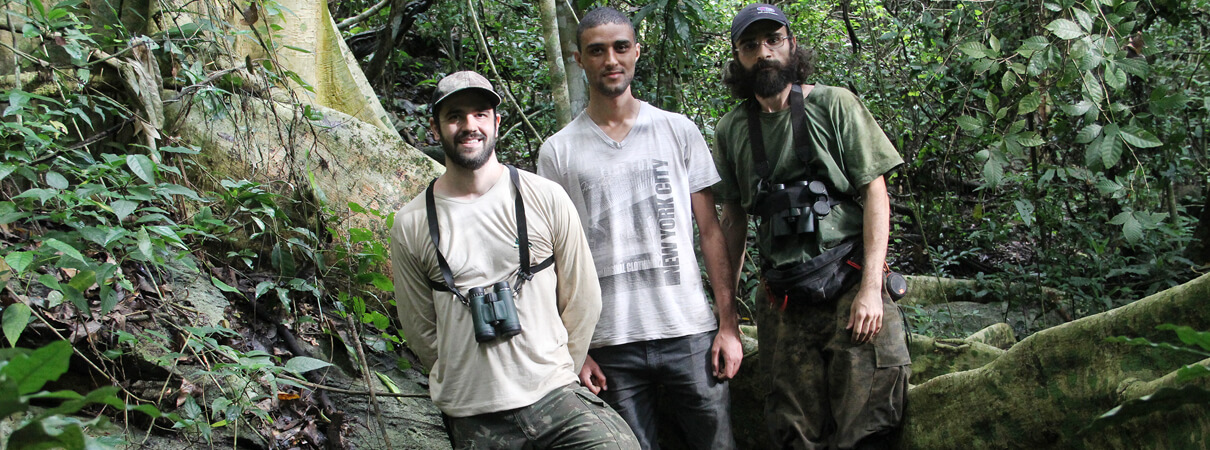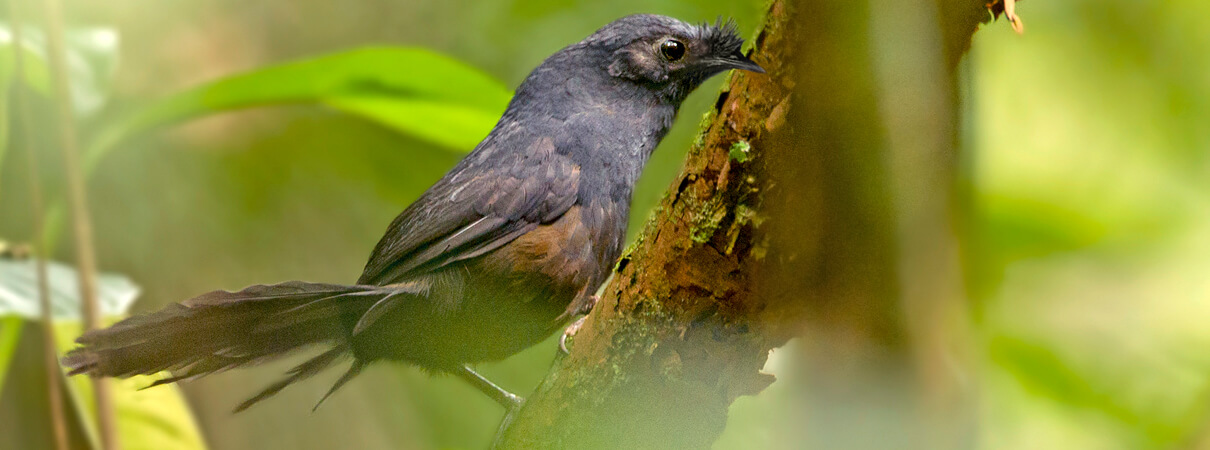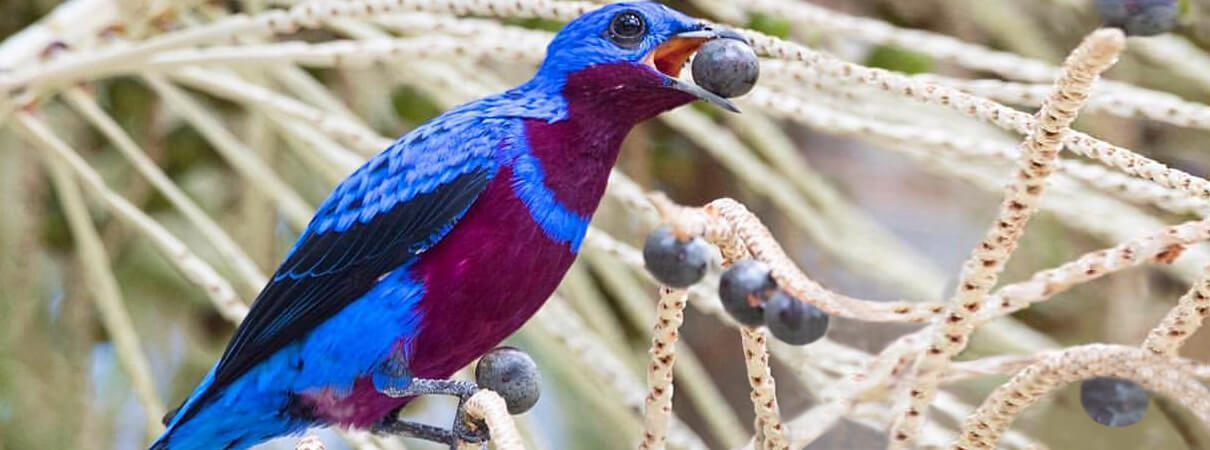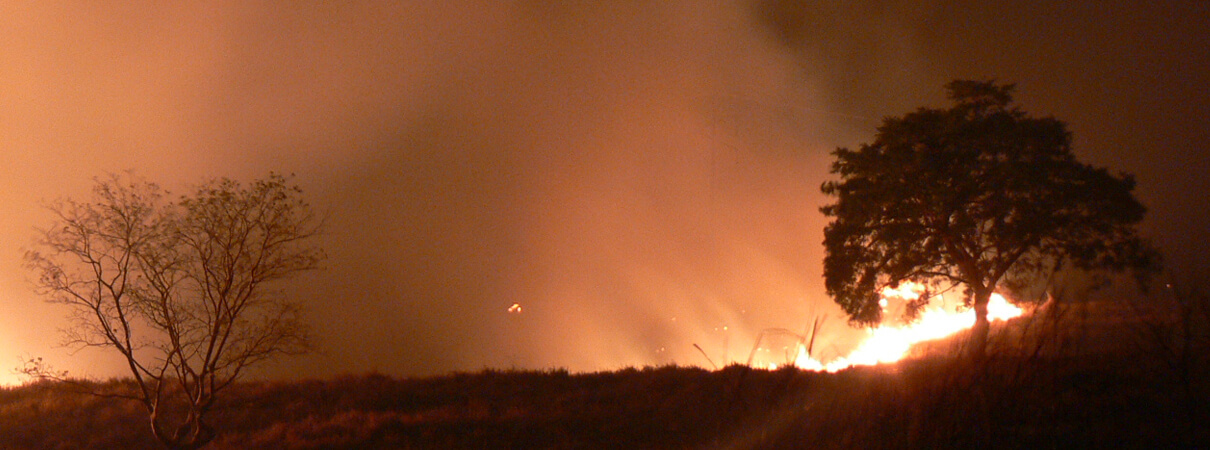Search for Feathered Treasure Is On In Brazil's Songbird Forest
An extensive search for one of the world's most endangered birds is underway, with Fundação Biodiversitas' Alexander Zaidan (below right) — a leading researcher on the species — leading the mission to find and save it.

The research team searching for the last remaining Stresemann's Bristlefronts in the world (left to right): José Eduardo Garcia Campos, Jhonattan Vilela Diogo, and Alexander Zaidan de Souza. Photo courtesy Fundação Biodiversitas
Stresemann's Bristlefront (Merulaxis stresemanni) occurs only in the Songbird Forest, or “Mata do Passarinho” Reserve, on the border of Bahia and Minas Gerais states in northeastern Brazil.
As an Alliance for Zero Extinction site, the Mata do Passarinho Reserve holds the last remaining known population of the Bristlefront. An updated census of this bird could help direct conservation and research efforts for a species on the brink of extinction due to habitat loss and continued disturbance.
Refinding a Lost Species
After going undetected for over 50 years and with its existence in question, Stresemann's Bristlefront was rediscovered in 1995 in the Atlantic Forest of the state of Bahia, Brazil. The Atlantic Forest is one of the most threatened biomes in the world, having been reduced to less than 10 percent of its original size.

Stresemann's Bristlefront. Photo by Ciro Albano_NE Brazil Birding
To protect this species, Brazilian partner Fundação Biodiversitas, American Bird Conservancy, Rainforest Trust, and others established the Mata do Passarinho Reserve in 2007. While we were encouraged by the discovery of an active nest in 2013, numbers remained worryingly low, with less than 15 individuals known in 2015.
It is no surprise that this endemic (only found in a specific area or region) bird with such a small population is a Critically Endangered species as well as one of the most threatened birds in the world. This reserve, also home to other rare bird species such as the Banded Cotinga, was expanded in early 2016 to a total size of 2,352 acres.
Quest to Re-find, and Save, the Species
In 2016, researchers only found a couple of Stresemann's Bristlefronts in the reserve, including a pair with a nest. The pair was seen several times carrying food into the underground nest, indicating the presence of offspring. Unfortunately, this pair did not have reproductive success and were unable to fledge any chicks, probably due to nocturnal predation of the nestling.

Banded Cotinga is another of the highly endangered bird species within the Songbird Forest reserve. Photo by Ciro Albano
Searches conducted during the 2017 breeding season in and near the reserve were unsuccessful. This result prompted an emergency meeting with researchers familiar with the Bristlefront, who agreed that while this is discouraging news, this species is difficult to detect, and searches should be continued.
Drought and Fire Add to Stress
Why has this species declined to such a highly threatened state? Already-low population numbers mean that even small disturbances could have major impacts on this species, and recent events have put added pressure on this tiny population.
In 2015-16, the fifth and worst consecutive year of extreme drought in northeastern Brazil — part of the worst drought ever recorded in this region — caused stress for many species. There was no rain during the usual rainy season in 2016, and the streams in the Mata do Passarinho Reserve ran dry.

Fires broke out in 2016 in the part of the reserve where the most Stresemann's Bristlefronts had previously been observed. Photo by Romulo Ribon
The last stronghold of Stresemann's Bristlefront was in a state of emergency. Worsening the situation, fires broke out in the southern portion of the reserve in 2016. The region with the highest number of observations of the species was directly impacted by the fires.
While we remain optimistic about finding additional individuals, catastrophic natural events like these could spell disaster for the species. Additional reserves and reforestation in surrounding areas will give this bird the best chance possible to survive and we hope someday, to thrive.
Brazilian partner Fundação Biodiversitas, American Bird Conservancy, Rainforest Trust, and others established the Mata do Passarinho Reserve in 2007. Mata do Passarinho is a demonstration site for a larger Global Enviroment Facility (GEF)-funded project, in partnership with UN Environment and BirdLife International.
ABC is providing financial support to continue searches both inside the reserve and in forest fragments outside of the reserve. Follow along with Alexander Zaidan: He will be updating us as the search continues, and we'll share his discoveries on the ABC Bird Calls blog and on ABC's social media channels through late November.

Jordan Rutter is a life-long birder with a passion for connecting others to the natural world through birds. With an M.Sc. in conservation biology from the University of Minnesota – Twin Cities and over ten years of experience in the ornithology field, she is ABC's Public Relations Director and currently serves on the Wilson Ornithological Society Council. Jordan also enjoys nature photography and gardening.


















































